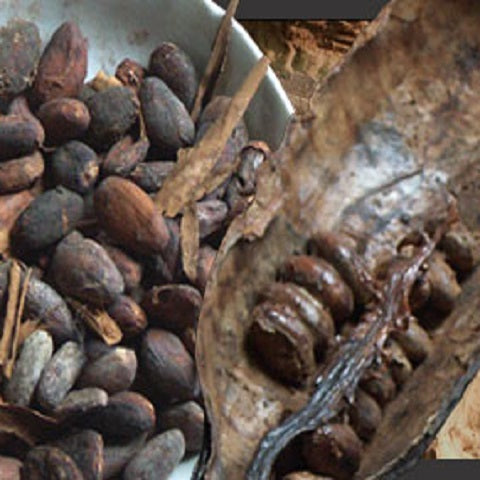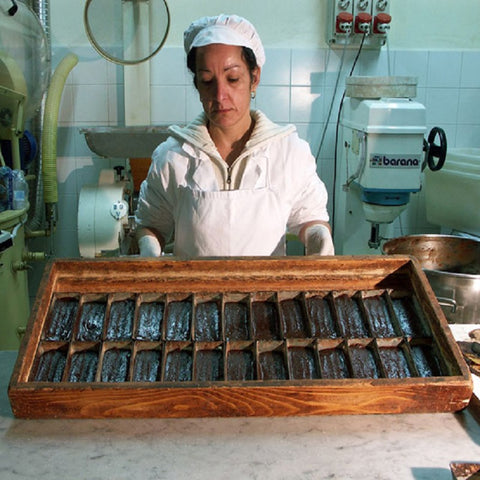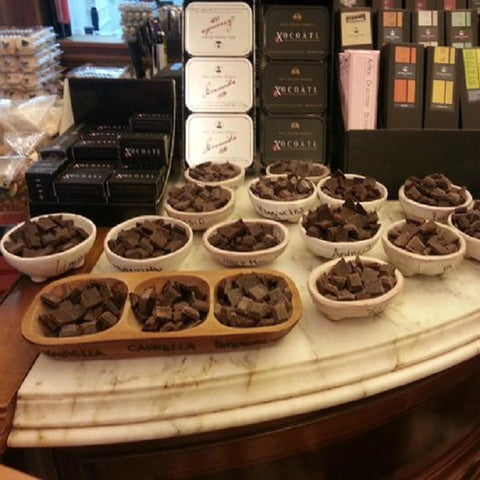


In 1880, Francesco Bonajuto, following in his father Frederico's footsteps, opened a small cake shop in the picturesque, baroque setting of Modica. From his shop, he brought forth exquisite cakes of Arabian and Spanish origin, the fruit of centuries-long traditions, earning acclaim and appreciation from the townspeople.
Bonajuto continued to create sweets with meticulous passion for years, hoping to preserve the art that he had grown up with, and of which he had become such an outstanding master.
Today, he would certainly be satisfied to know that the 'Dolceria' is still in the place where he founded it, and that it represents a fundamental reference point for the culinary tradition to which he was so closely bound. A hundred years later, the wooden-panelled shop still makes heavenly award winning cinnamon, vanilla and chilli chocolate in true Aztec style. To know the products of the Antica Dolceria Bonajuto is to know an infinity of flavours unknown to most -- ancient flavours unchanged by the passing of time.
Not only do they have out-of-worldly chocolates, but there are also many other wonderful treats the dolceria has been making for decades: Qubaita and Aranciata, a sesame seeds nougat and an orange peel and honey delicacy of arab origin, Nucatoli an S shaped biscuits filled with almonds, honey, dried figs and quince jam, Dolcetti da riposto small marzipan morsels to have with rosolio, 'Mpanatigghi, pastry stuffed with an incredible mixture of ground meat (beef fillet), chocolate and a mixture of spices, almond biscuits, cannoli as well as the latest creations like Maris, an interesting chocolate with tuna row, seaweeds and white chocolate.
This makes wonderful gifts, because you are not just gifting a sweet, but an edible piece of history!
The story of their chocolate winds its way down a path which, going backwards in history, unites Sicily with Spain, particularly the County of Modica. Even further back, their chocolate finds its origin in the marvelous, ceremonial civilisation of the Aztecs, the ancient inhabitants of Mexico.
When the "New World" was discovered, the Spanish found an extraordinary variety of foods. 'Xocoàtl' was made by the inhabitants with cocoa seeds, and was held in great regard because it conferred strength and vigour and was also a sign of wealth. The Aztecs made the 'Xocoàtl' using a special rolling pin made of stone, grinding the cocoa seeds on a tool called a 'metate', a curved stone placed on two transversal base stones. The cocoa flour produced was then mixed with spices, and the mixture was rubbed on the metate until it hardened.
During their domination in Sicily, the Spaniards introduced the method of making chocolate that they had learned from the Aztecs. This chocolate, in contrast to later versions throughout Europe, never became industrially produced and has remained unchanged through the centuries. Still today, the Antica Dolceria Bonajuto makes chocolate with the same ancient technique and ingredients.
The production technique used to make their chocolate is very similar to that used by the Aztecs at the time of the discovery of the New World. They begin with a mass of semi-ground cocoa that still contains its cocoa butter.
The mass is heated to make it fluid, and at a precise temperature, it is mixed with castor sugar and spices (cinnamon or vanilla). The mixing is done with a "refiner", a modern-day replacement of the metate.
The mixture is kept at a temperature that prevents the sugar crystals from melting (they remain an integral part of the chocolate bar). The final phase consists of spreading the mixture into forms, which will then be pounded to ensure that the chocolate takes the desired shape.
This particular "cold working" of the chocolate excludes the phase of conching, which many think is the secret to keeping flavours alive that would otherwise disappear. The strength of this particular product is the simplicity of the technique and the fact that there is no addition of butter or other extraneous substances (vegetable fats, milk derivatives or lecithin).
Bonajuto's chocolate is composed only of a mixture of cocoa, sugar and spices -- a final link with those distant peoples whose history they share and whose beliefs about the benefits of chocolate have been passed on through time. Indeed, the scent of our chocolate is believed to be beneficial in cases of bronchitis or general respiratory problems.
Modica is a town where the wonderful figure of the "ciucculattaru" ('chocolate-man') once could be found. An unknowing colleague of his Spanish counterpart, he carried the metate around with him from door to door on a cart to produce the chocolate that the townsfolk regarded more as a nourishing food than a sweet. This is the story of their chocolate, which has passed through the centuries with it's original purity intact.
"...chocolate of astonishingly pure, powerful flavor..."
The New York Times
"...Is unparalleled in savor, tasting it is like reaching the archetype, the absolute, and that chocolate produced elsewhere, even the most celebrated, is an adulteration, a corruption of the original..."
International Herald Tribune
"...none of the taste or beneficent nutritional properties of the cacao are lost..."
Financial Times
"...gritty, grainy cold-milled dark chocolate adored by the cognoscenti from LA to Tokyo..."
...Bonajuto chocolate is not a blend but a timed sequence of flavors. First the aromatic bitterness of the chocolate, then the sweetness of sugar, then 1) the smoky kapow of the vanilla or 2) the hot explosion of cinnamon...
Wall Street Journal
"...This is connoisseurs’ chocolate and similar to the way the Aztecs originally prepared it..."
Andrew Harpers